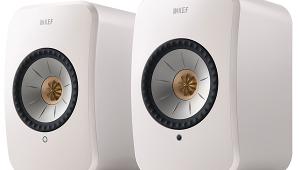Review: NAD Viso 1 Wireless Digital Music System

I don’t want to call Paul Barton a brilliant speaker designer, because that might imply that he lucks into occasional flashes of inspiration. No, Barton — founder and chief engineer of PSB Speakers — succeeds because he does the complicated and time-consuming work of building his products using the best science and engineering available. He doesn’t base his design decisions on pet theories, casual observations, or the latest line of B.S. circulating among online audio forums. And to my knowledge, he’s never allowed market trends, cosmetics, or form factors to ruin the sound of his products.
This is why I was so excited to find out last year that Barton was designing a new iPhone/iPod Touch dock for NAD, PSB’s sister brand.
There have been plenty of OK-sounding docks, but few that have really delivered the serious sound quality for which Barton’s creations are revered.
Sleek the NAD Viso 1 is not. Its look recalls neither art, aircraft, nor autos. To me it looks like a miniature beer keg, as designed by Philippe Starck. The cylindrical shape holds a 5.75-inch woofer and two 2.75-inch midrange/tweeters. A 50-watt digital amp drives the woofer, and two 15-watt digital amps drive the mid/tweets. The mid/tweets fire at a slight upward angle (about 20 degrees, Barton told me).
The Viso 1 borrows from NAD’s own technology portfolio, too. Digital signal processing divides the signals for the woofer and mid/tweeters at 500 Hz, with no power-robbing passive components (i.e., resistors, capacitors, or inductors) between the amps and drivers. The digital amps employ a digital version of NAD’s longstanding Soft Clipping technology, which is said to reduce audible distortion. For maximum sound quality, the Viso 1’s digital volume control re-dithers the signal rather than simply truncating digital audio bits.
A mount on the front accommodates an iPhone or an iPod touch. You can spin the mount 90 degrees, so the docked device can be viewed in portrait (vertical) or landscape (horizontal) mode — especially handy for watching videos on your phone.
Bluetooth aptX wireless lets your non-Apple smartphones (and Bluetooth-equipped computers) communicate with the Viso 1. Other audio devices may give you problems, though, because the Viso 1 is the first iPod dock I’ve encountered that didn’t have a 3.5mm analog input. However, it does have a Toslink optical digital audio input, so it can connect to a Toslink-equipped DVD, Blu-ray Disc, or CD player, or to most flat-panel TV sets.
NAD offers an optional wall-mount for the Viso 1, as well as an optional mount that integrates it with an Apple TV set-top box.
The Viso 1 originally listed for $700, but right before this review posted, the company reduced the price to $600.
Me so Viso
I enjoyed using the Viso 1, in large part because it eschews useless features and superfluous controls. And it doesn’t hide its controls for the sake of cosmetics.
The curved bar holding the dock mechanism provides a convenient handle, which made it easy for me to haul the Viso 1 anywhere around my house. An on/off button on the sides powers it up. A source select button and volume up/down buttons on the “handle” control the basic functions. There’s a somewhat obligatory little remote that controls all the above functions and also lets you do track skip on the docked device.
Mating the Viso 1 with my Motorola Droid Pro smartphone through Bluetooth took only a few seconds, as usual.
There’s only one “hidden” feature that you wouldn’t discover without the manual — a nearfield EQ mode that slightly reduces treble response for situations where you’re listening at a close distance, such as on your desktop. To access this mode, you hold down the source button until the power indicator blinks, then hit the volume minus (-) button to activate the nearfield EQ.
Wish I had more to report on the design and ergonomics, but this thing basically just works — a characteristic that’s all too rare in consumer electronics these days.
- Log in or register to post comments






























































